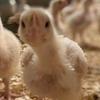Nesting behavior and floor eggs in cage-free housing

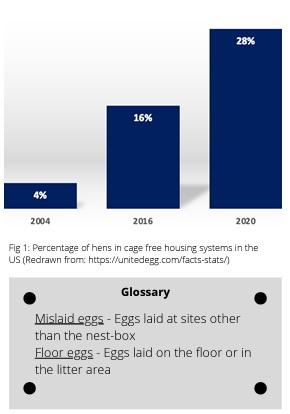
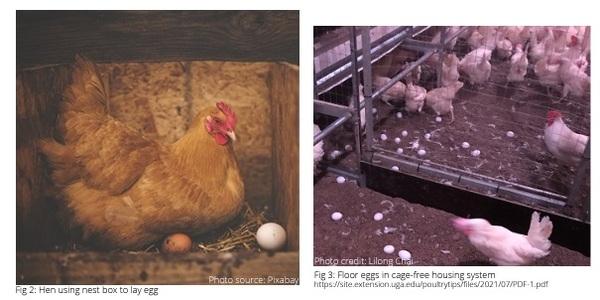
- Nest: Hens can compete for a preferred nest site within the housing system. This preference for a common nest site might result in crowded nests. When the nests are crowded, some hens might lay their eggs outside the nest-box.
- Age: The incidence of floor eggs is usually seen during earlier stages of the laying cycle. As hens get older, floor eggs become less prevalent indicating that nest-use is, partly, a learned behavior.
- Genetics: Light-weight layer hybrids often lay fewer floor eggs than medium-weight hybrids.
- Light: Hens prefer to lay eggs in corners or other dark areas within the house. Lighting fixtures that do not provide adequate illumination can create shaded areas within the system which can promote occurrences of floor eggs.
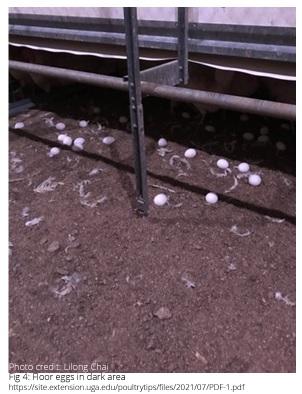
- Economic Loss: Floor eggs cannot be sold as table eggs in the US. Additionally, higher percentages of floor eggs increase the labor cost of egg collection, resulting in further economic loss.
- Food Safety: Floor eggs are more likely to be contaminated with microbes from chicken excreta and can pose a potential food-safety risk in countries where they can be sold for consumption.
- Vent Pecking: Hens that lay eggs on the floor are at greater risk of being pecked and injured by other hens.
- Broken Eggs: Floor eggs have greater probability of being pecked and eaten which can result in learned egg-eating behavior in the flock.
- Perch: Perching is a highly motivated behavior of the hen. Perches are elevated structures where birds generally rest and preen. Birds jump from the ground to reach the perch. Jumping activity can strengthen the muscles and skeleton of hens and can prepare them to reach the raised nest-box with ease. Allowing birds to perch as early as 4 weeks of age decreases the incidence of floor eggs. To make young hens familiar with perches, drinkers are often placed at the level of the perch.
- Training: Pullets are generally transferred to a laying pen before the start of the laying phase. During the initial period, it is important to train the birds to move into the nest-box. The handler should encourage the birds towards the nest-box without causing stress. Frequency of nest visits by hens can be increased by placing drinkers and feeders closer to the nest-box.
- Use of light: Majority of hens in a flock complete egg-laying within 5 hours of lights-on in the morning. Applying dim light at the nest and bright light at other places can encourage layers to move into the nest area.
- Nest: Adequate nest space should be provided based on the number of hens within the housing system. Inadequate nest space causes overcrowding in the nest-box and drives some hens towards laying outside the nest area. During early stages of the laying cycle, nest should be kept open to encourage the birds to explore the area and become habituated. Once habituated, nest box should only be opened during the peak laying period of the day. This will help keep the nest-box clean by preventing the hens to use it for a longer period of time and excreting on it.
- Transfer of birds to the laying pen: The age at which pullets are transferred to the hen house can also determine the incidence of floor eggs. In one study, hens transferred later in life (23 weeks) had greater incidence of floor eggs compared to those that were transferred early (18 weeks). Early transfer of pullets into the hen house allows sufficient time for them to learn to use the nest-box.
- Nutrition: A high fiber diet consisting of whole grain wheat has been observed to reduce the incidence of floor eggs.
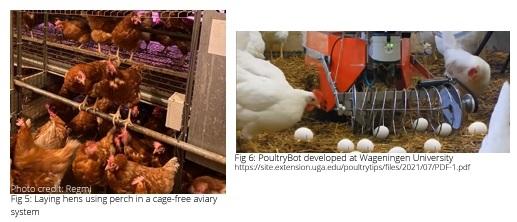
- Nesting behavior is a highly motivated behavior in laying hens that allows a hen to find a suitable area to lay the egg.
- Floor eggs are commonly seen in cage-free housing system and poses management and economic challenges to producers.
- Several environmental factors as well as the genetics of the hen can influence the incidence of floor eggs within a flock.
- Floor eggs can be minimized through provision of adequate nest-boxes, training during rearing and early-lay period, and manipulating lighting arrangement to discourage hens to use the floor for egg laying.
Abrahamsson, P., & Tauson, R. (1998). Performance and Egg Quality of Laying Hens in an Aviary System. Journal of Applied Poultry Research, 7(3), 225–232. https://doi.org/10.1093/japr/7.3.225
Appleby, M. C. (1984). Factors Affecting Floor Laying By Domestic Hens: A Review. World’s Poultry Science Journal, 40(3), 241–249. https://doi.org/10.1079/WPS19840019
Campbell, D. L. M., Makagon, M. M., Swanson, J. C., & Siegford, J. M. (2016). Perch use by laying hens in a commercial aviary. Poultry Science, 95(8), 1736–1742. https://doi.org/10.3382/ps/pew111
Dorminey, R. W. (1974). Incidence of Floor Eggs as Influenced by Time of Nest Installation, Artificial Lighting and Nest Location1. Poultry Science, 53(5), 1886–1891. https://doi.org/10.3382/ps.0531886
Gunnarsson, S. (1999). Effect of rearing factors on the prevalence of floor eggs, cloacal cannibalism and feather pecking in commercial flocks of loose housed laying hens. British Poultry Science, 40(1), 12–18. https://doi.org/10.1080/00071669987773
Horsted, K., & Hermansen, J. E. (2007). Whole wheat versus mixed layer diet as supplementary feed to layers foraging a sequence of different forage crops. Animal, 1(4), 575–585. https://doi.org/10.1017/S175173110769418X
McBride, G., Parer, I. P., & Foenander, F. (1969). The Social Organization and Behaviour of the Feral Domestic Fowl. Animal Behaviour Monographs, 2, 125–181. https://doi.org/10.1016/S0066-1856(69)80003-8
Settar, P., Arango, J., & Arthur, J. (2006). Evidence of genetic variability for floor and nest egg laying behavior in floor pens.
Sheppard, K. C., & Duncan, I. J. H. (2011). Feeding motivation on the incidence of floor eggs and extraneously calcified eggs laid by broiler breeder hens. British Poultry Science, 52(1), 20–29. https://doi.org/10.1080/00071668.2010.550600
Stämpfli, K., Buchwalder, T., Fröhlich, E. K. F., & Roth, B. A. (2012). Influence of front curtain design on nest choice by laying hens. British Poultry Science, 53(5), 553–560. https://doi.org/10.1080/00071668.2012.725201
USDA National Agricultural Statistics Service. (2021). NASS - Quick Stats. USDA National Agricultural Statistics Service.
van den Brand, H., Sosef, M. P., Lourens, A., & van Harn, J. (2016). Effects of floor eggs on hatchability and later life performance in broiler chickens. Poultry Science, 95(5), 1025–1032. https://doi.org/10.3382/ps/pew008
van den Oever, A. C. M., Kemp, B., Rodenburg, T. B., van de Ven, L. J. F., & Bolhuis, J. E. (2021). Gregarious nesting in relation to floor eggs in broiler breeders. Animal, 15(1), 100030. https://doi.org/10.1016/j.animal.2020.100030
van den Oever, A. C. M., Candelotto, L., Kemp, B., Rodenburg, T. B., Bolhuis, J. E., Graat, E. A. M., van de Ven, L. J. F., Guggisberg, D., & Toscano, M. J. (2021). Influence of a raised slatted area in front of the nest on leg health, mating behaviour and floor eggs in broiler breeders. Animal, 15(2), 100109. https://doi.org/10.1016/j.animal.2020.100109
Villanueva, S., Ali, A. B. A., Campbell, D. L. M., & Siegford, J. M. (2017). Nest use and patterns of egg laying and damage by 4 strains of laying hens in an aviary system1. Poultry Science, 96(9), 3011–3020. https://doi.org/10.3382/ps/pex104
Wolc, A., Settar, P., Fulton, J. E., Arango, J., Rowland, K., Lubritz, D., & Dekkers, J. C. M. (2021). Heritability of perching behavior and its genetic relationship with incidence of floor eggs in Rhode Island Red chickens. Genetics Selection Evolution, 53(1), 38. https://doi.org/10.1186/s12711-021-00630-5.







United States



